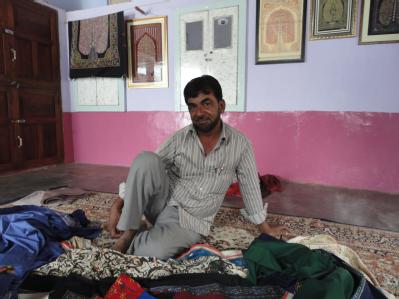Sumar Khatri
Interview Summary
Originating in medieval Persia, rogan work consists of extremely detailed and elegant painted or embossed fabric. Migration and cultural exchange introduced the art form to Kachchh around four hundred years ago. The rogan artists of Kachchh are known as the Chapparas (those who imprint) although the word ‘rogan’ is derived from a Persian term for ‘oil-based’. The rogan art form is not well-known beyond textile buyers and certain specialists, and is now only produced in a few parts of Gujarat, one of which is the village of Nirona in Kachchh.
Sumar Khatri was the first rogan artisan we interviewed. He felt strongly that more support should be provided to ensure the stability of his art form, and expressed his wish for rogan to be more widely known. He told us that, around fifty to sixty years ago, rogan work was not particularly highly valued outside of certain communities. Ahir women wore rogan-painted ghagras (skirts) and odhanis, and the Muttwas also commissioned work from rogan artists. Such demand provided a limited income for Sumar’s forefathers, who could earn around five to six hundred Rupees for the work. Frustrated by this meagre value and limited demand, Sumar told us that his elder brother Abdul Gafur gave up the work and moved to Mumbai in search of a new livelihood. Back home, his grandfather continued the work. In 1984-85, Gafur responded to his grandfather’s call to return to finish an important order; at this time too, the government’s initiatives to support and encourage artisans provided much needed help. Gafur even won a state award for his rogan work in 1988. Sumar felt that his family’s craft thrived after this point and they went on to receive a range of national awards in the 1990s.
Rogan is prepared by boiling safflower, linseed or castor oil over two days. During this process the oil is highly flammable and a dhakni (a clay lid) is used to suppress any flame. After cooling, the substance is thickened by mixing in colouring agents, derived from a variety of mineral and eco-friendly sources. The colour pastes - yellow, red, white, green, black and orange - are kept in earthen pots with water to keep them moist and to retain their malleability. The colour must also be kept free from other chemicals, and must be used within two to three weeks, or it will spoil.
Usually, the designs are drawn freehand, without any tracing, on a piece of cotton or silk. Artisans used their own artistic knowledge and imagination to create the vibrant designs and patterns. With the help of an iron rod, flat at both ends, a single line of oil pastel can re rubbed and stretched to form floral and spotted embossed patterns. These fine designs are extremely intricate and require intense patience and a steady hand. Perhaps the most prized design in the Tree of Life. Sumar connects it with the Hindu Kalpvruksh. The Tree of Life is adorned with exotic enamel or meenakari, and gold and silver colours added to create the beautiful finished design. A full design can take many months or years to complete. Once the painting is complete, the blank side of the fabric is pressed to create a mirror image. This has to be done with the utmost care to avoid damaging the design; even with great care, Sumar adds, mild smudging often occurs.
The roganists have been visited by tourists from sixty countries, including the USA, England, France, Italy, Israel, Switzerland and Germany. In recent years, more Indian buyers have emerged perhaps reflecting a growing domestic interest in the craft. Despite these developments, Sumar feels more can be done to publicise rogan, perhaps through the BDOs (Block Division Officers) of Kachchh, regional officials and even NGOs. Some initiatives, such as the Gujarat state promoted tourism through the annual Rann festival has little benefit as tourists often attend the festivities and often leave without seeing the rogan artisans’ work. Nevertheless, Sumar felt strongly that foreign finance can be helpful, and recently participated in a tourism promotion advertisement with the India film icon Amitabh Bachan. For Sumar, the key issue is that there seems to be a general lack of awareness about the technique and creation of rogan pieces; the art continues to be thought of as simply a printed or embroidered piece of fabric.
Sumar’s nephew Sahil (Gafur’s son) has just joined the family business; the eighth generation of the family that has pursued this rare art form.

